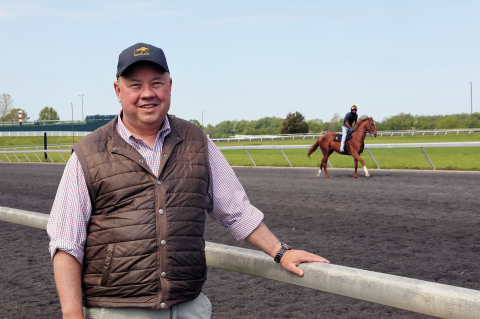
Enhanced Veterinary Inspections And Monitoring Strengthen Safety Protocols
Keeneland Vice President of Equine Safety Dr. Stuart Brown and Racing Safety Officer Dr. George Mundy have initiated innovative strategies in furtherance of the track’s commitment to safety and welfare.
Protocols include mandatory veterinary inspections prior to workouts and race entry along with enhanced medical reporting and transparency requirements for trainers and attending veterinarians with regard to the fitness of horses to work and race.
Horses are examined at their barns and on the track every day. These evaluations focus on the well-being of each horse and become the foundation for decisions made on the horse’s behalf regarding competing, seeking further diagnostics, scheduling time off or considering other suitable options.

“The single most important opportunity we have to positively impact the welfare of the equine racing athlete can be found in the creation of these unique examinations centered on the well-being of every horse who touches our racing surface,” Dr. Brown said. “By defining the parameters contained within the Equine Safety Agreements we have with our horsemen, we create the qualitative approach to advocate for the safety of each horse that resides at Keeneland and TTC. The outcomes of these conversations among the advocates who care for these horses allow us to assess their suitability to compete safely on our racing surfaces.”
Dr. Brown and Dr. Mundy worked with Keeneland’s Broadcast Services team to create a network of video cameras that capture footage of horses training and racing over Keeneland’s dirt and turf surfaces and all-weather training track. The system that monitors and evaluates horses for safety purposes is the first at a U.S. race track.

Stationary cameras that pan, tilt and zoom provide multiple views of horses on each track. Dr. Mundy can control camera positions and record video from his perch on the fourth-floor Grandstand overlooking the main track. He communicates with Dr. Brown, who is trackside and in the stable area throughout the race day. The two share observations about horses training, warming up before races and galloping out after races. If needed, they can provide video to state veterinarians, stewards and trainers anywhere on track for viewing.
“Twenty-five years of information gathering has taught us that a horse at risk of injury falls somewhere in the Bone Stress Continuum,” Dr. Mundy said. “Horses are honest and changes in their routine exercise gaits are often early indicators of ongoing or impending injury. Keeneland’s video surveillance program is yet another tool for horsemen and veterinarians to enhance the safety of our racing and training populations each and every day.”
Keeneland reports information about horses that are injured during racing or training to the Jockey Club Equine Injury Database (EID). The EID is a national database created to track racing injuries in an effort to identify the frequency, types and outcome by using a standardized format that generates valid statistics, identifies markers for horses at increased risk of injury and serves as a data source for research directed at improving safety and preventing injuries.